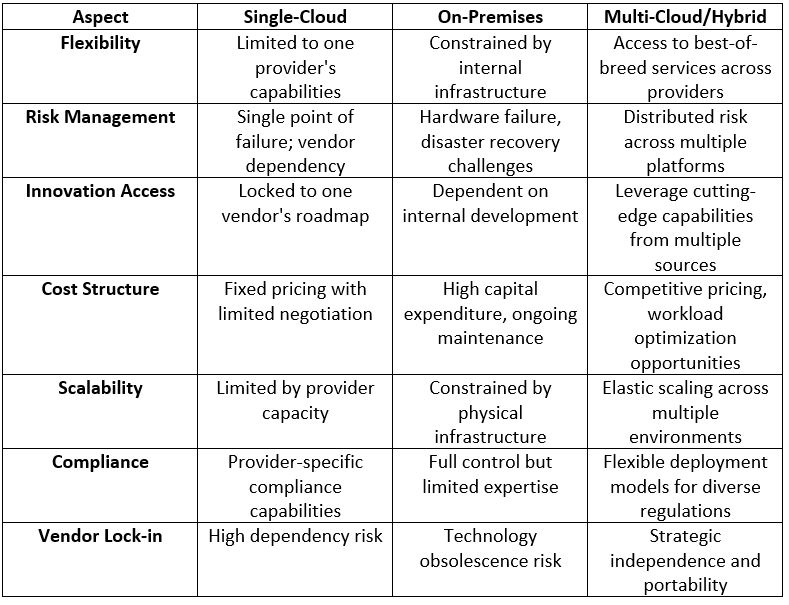Redefining Cloud Architecture: The Rise of Multi-Cloud and Hybrid Environments in Enterprise Solutions
“Enterprise multi-cloud strategy planning transcends traditional infrastructure decisions, demanding sophisticated hybrid cloud governance best practices. Organizations implement workload placement multi-cloud optimization while maintaining cloud cost management in hybrid environments to achieve superior competitive positioning. Secure multi-cloud integration solutions enable legacy system modernization hybrid cloud approaches, supporting cloud native architecture multi-cloud adoption. Multi-cloud frameworks prevent vendor lock-in and improve disaster recovery, ensuring cloud portability enterprise workloads across diverse technological ecosystems.”
The enterprise technology space has fundamentally shifted from monolithic cloud approaches toward nuanced, distributed architectures that span multiple providers and deployment models. Multi-cloud and hybrid environments have transitioned from niche implementations to foundational requirements for organizations seeking competitive agility and sustained innovation capacity. Gartner research shows that hybrid cloud implementations deliver 40% better disaster recovery capabilities compared to single-provider solutions. [16]
This architectural evolution represents more than technological advancement; it signifies a strategic business transformation that determines organizational capability to respond to market dynamics, regulatory requirements, and customer expectations. Strategic adoption of distributed cloud architectures serves as the critical foundation for achieving genuine digital transformation, moving beyond superficial modernization efforts toward comprehensive organizational capability enhancement.
Beyond the Initial Ascent: Why Today's Cloud Demands a New Blueprint
The initial wave of cloud adoption is typically centered on single-provider strategies, often driven by cost reduction objectives and basic infrastructure modernization needs. While these early implementations delivered immediate operational benefits, they frequently created new limitations that constrain long-term strategic flexibility.
As articulated by forward-thinking technology leaders: “Once the digital strategy is clear, the next priority is modernizing the underlying infrastructure. Hybrid and multi-cloud are not trends—they’re realities. Without scalable and resilient cloud environments, transformation remains a buzzword”.
This perspective acknowledges the critical interdependence between strategic vision and infrastructure capability. Multi-cloud and hybrid architectures function not merely as technological upgrades but as strategic business enablers that support complex operational demands, regulatory compliance requirements, and innovation objectives that single-provider solutions cannot adequately address. According to Flexera’s 2024 State of the Cloud Report, organizations implementing multi-cloud strategies achieved an average of 23% cost reduction compared to single-cloud deployments. [17]
The contemporary enterprise question has evolved from “which single cloud provider should we select” to “how do we strategically orchestrate multiple cloud environments to optimize business outcomes while maintaining operational excellence and cost efficiency”.
The Modern Cloud Spectrum: Differentiating Multi-Cloud and Hybrid for Strategic Advantage
Forrester’s 2024 Cloud Strategy Survey reveals that organizations with mature multi-cloud strategies deploy new applications 45% faster than those relying on single-cloud providers. [18]
- 1. Multi-Cloud: The Power of Choice and Specialization
Multi-cloud architectures involve the strategic utilization of best-of-breed services from multiple public cloud providers, enabling organizations to optimize specific workloads while accessing diverse technological capabilities. This approach supports enterprise multi-cloud strategy planning by allowing organizations to select the most appropriate services for particular use cases rather than accepting compromise solutions from single providers.
The strategic intent behind multi-cloud adoption centers on workload placement multi-cloud optimization, fostering innovation through access to diverse toolsets, and implementing vendor lock-in prevention multi-cloud strategies that preserve long-term flexibility. Organizations frequently implement artificial intelligence and machine learning workloads on one provider’s specialized platforms while utilizing another provider’s superior data warehousing capabilities and a third provider’s content delivery network infrastructure.
This specialization approach enables organizations to access cutting-edge capabilities across multiple domains while maintaining the flexibility to adapt as technological capabilities evolve and business requirements change.
- 2. Hybrid Cloud: Balancing Control with Scalability
Hybrid cloud architectures represent the purposeful integration of private cloud or on-premises infrastructure with public cloud services, creating environments that balance security and compliance requirements with public cloud elasticity. Legacy system modernization hybrid cloud approaches enable organizations to modernize infrastructure incrementally while maintaining control over sensitive data and critical applications.
The strategic intent behind hybrid implementation focuses on maintaining appropriate security and compliance postures for sensitive data while leveraging public cloud scalability for variable workloads and new application development. Organizations commonly retain customer personally identifiable information and regulated data on-premises while utilizing public cloud resources for scalable front-end applications, development environments, and surge capacity requirements.
Hybrid architectures also support disaster recovery multi-cloud strategy implementation by providing multiple infrastructure tiers and recovery options that enhance business continuity capabilities.
- 3. The Symbiotic Relationship
Contemporary enterprise architectures increasingly implement hybrid multi-cloud approaches that combine the control benefits of hybrid deployment with the specialization advantages of multi-cloud strategies. These implementations are not mutually exclusive but rather complementary approaches that address different aspects of enterprise requirements while maximizing strategic flexibility and operational capability.
- 4. Strategic Comparison

- Success Stories
- 1) Client: HSBC
The Multi-Cloud Strategy: HSBC has publicly embraced a multi-cloud strategy to accelerate its digital transformation, enhance security and compliance, and leverage the best-in-class services from different cloud providers. The bank has publicly announced strategic collaborations with Amazon Web Services (AWS) and Google Cloud Platform (GCP) and also utilizes Microsoft Azure. [8] [9]
- 2) Client: Groupe Renault
The Multi-Cloud Strategy: The Renault Group has adopted a comprehensive “Industry 4.0” transformation that heavily relies on a multi-cloud strategy to improve manufacturing efficiency, optimize its supply chain, and develop connected vehicle services. The company has a strategic partnership with Google Cloud and also leverages Microsoft Azure and Amazon Web Services (AWS). [10]
- 3) Client: MedStar Health
The Hybrid Cloud Strategy: MedStar Health adopted a hybrid cloud architecture to support its rapid telehealth expansion during the COVID-19 pandemic. Sensitive patient data remained on-premises to comply with HIPAA regulations, while AWS was used to scale telehealth services using Amazon Connect and other cloud-native tools. This approach enabled a 300% increase in telehealth capacity during peak demand, ensuring continuity of care while maintaining regulatory compliance. [11]
- 4) Client: U.S. Government Department
The Hybrid Cloud Strategy: A major U.S. government department modernized its IT infrastructure by adopting a hybrid cloud model. Sensitive citizen data was retained in private cloud environments to meet data residency and sovereignty requirements. Public cloud platforms were used to host scalable citizen service portals and non-sensitive workloads. This strategy led to a 60% reduction in infrastructure costs and a 75% improvement in resource efficiency, all while maintaining strict compliance standards. [12]
- 5) Client: Global Retailer
The Multi-Cloud Strategy: A multinational retail company implemented an intelligent workload placement strategy across multiple cloud providers. Batch processing and analytics workloads were routed to the most cost-effective cloud platforms, while customer-facing applications were hosted on high-performance infrastructure to ensure optimal user experience. This multi-cloud approach resulted in a 35% reduction in operational costs and improved agility in responding to market demands. [13]

The Irresistible Pull: Key Business Imperatives Driving Multi-Cloud and Hybrid Adoption
- 1. Innovation and Agility Enhancement
Multi-cloud and hybrid architectures provide access to specialized services and cutting-edge capabilities that extend far beyond basic compute and storage resources. Organizations gain access to advanced artificial intelligence platforms, Internet of Things processing capabilities, and specialized services unique to different providers, enabling innovation that would be impossible within single-provider constraints.
Cloud native architecture multi-cloud adoption supports rapid application development and deployment while maintaining cloud portability enterprise workloads across different environments, ensuring that innovation investments remain protected as requirements evolve.
- 2. Resilience and Risk Mitigation
The strategic imperative of business continuity in an increasingly unpredictable global environment drives organizations toward distributed architectures that avoid single points of failure. Disaster recovery multi-cloud strategy implementations provide multiple recovery options and infrastructure diversity that single-provider solutions cannot match.
Organizations implementing comprehensive multi-cloud approaches reduce concentration risk while enhancing their capability to maintain operations during provider outages, regional disruptions, or service limitations that could otherwise create significant business impact.
- 3. Cost Optimization and Value Realization
Moving beyond basic lift-and-shift migrations toward intelligent workload placement enables organizations to optimize costs while maximizing value from cloud investments. Cloud cost management in hybrid environments requires a sophisticated understanding of workload characteristics, performance requirements, and provider pricing models to achieve optimal resource allocation.
The emergence of Financial Operations (FinOps) as a critical organizational discipline reflects the complexity and importance of managing costs across distributed cloud environments while maintaining performance and capability objectives.
- 4. Regulatory Compliance and Data Sovereignty
Global regulatory requirements, industry-specific compliance mandates, and data sovereignty considerations increasingly require sophisticated deployment strategies that single-provider solutions cannot adequately address. Secure multi-cloud integration solutions enable organizations to maintain compliance while accessing necessary capabilities across different jurisdictions and regulatory frameworks.
Organizations operating in multiple countries or regulated industries must implement architectures that support data localization requirements while maintaining operational efficiency and user experience quality.
- a) Navigating Global Regulatory Frameworks
The European Union’s General Data Protection Regulation (GDPR) requires strict data localization and processing controls, often necessitating hybrid architectures that maintain EU citizen data within European borders while enabling global operations. Similarly, the California Consumer Privacy Act (CCPA) imposes specific requirements for personal data handling that influence cloud architecture decisions for organizations serving California residents.
In the Asia-Pacific region, countries like China, India, and Singapore have implemented data localization requirements that mandate certain data types remain within national boundaries. Financial services organizations operating globally must comply with regulations such as PCI DSS, Basel III, and local banking regulations that often require specific security controls and audit capabilities that influence multi-cloud and hybrid deployment strategies.
Organizations in regulated industries like healthcare must address HIPAA requirements in the United States, similar privacy regulations in Canada, and varying healthcare data protection standards across European countries. These regulatory requirements often drive hybrid cloud adoption where sensitive data remains on-premises or in region-specific cloud instances while less sensitive operations leverage global cloud capabilities.
- 5. Performance and User Experience Optimization
Addressing the Inherent Complexities of Distributed Cloud Environments
- 1. The Management Challenge
Unified management across disparate platforms requires sophisticated tooling, standardized processes, and specialized skills that differ significantly from single-provider management approaches. Organizations must implement management platforms that provide consistent visibility and control across heterogeneous environments while maintaining the flexibility that drives multi-cloud adoption.
Hybrid cloud governance best practices require standardized approaches to security, compliance, and operational management that function effectively across different infrastructure types and service models.
- 2. Security and Governance Extension
Extending robust security postures and consistent governance frameworks across heterogeneous environments presents complex challenges that require new approaches to identity management, access control, and compliance monitoring. Organizations must implement security architectures that function effectively across different providers while maintaining visibility and control over distributed assets.
The traditional security perimeter concept becomes obsolete in distributed cloud environments, requiring zero-trust architectures and identity-centric security models that function effectively across multiple platforms and deployment models.
- a) GDPR – Right to Be Forgotten in Multi-Cloud Environments – The GDPR’s “right to be forgotten” mandates that individuals request complete erasure of their personal data. In multi-cloud environments, this requires data architectures to support traceable, synchronized deletion across all cloud providers. Organizations must implement unified data governance, metadata tagging, and automated erasure workflows to ensure compliance while maintaining operational efficiency. [14]
- b) SOX Compliance in Hybrid Cloud Financial Systems – SOX compliance demands strict internal controls, data integrity, and auditability for financial reporting. In hybrid cloud architectures, this influences decisions on where and how financial data is stored and processed. Organizations must ensure centralized access controls, encrypted data flows, and consistent audit trails across on-premises and cloud systems to meet SOX’s rigorous transparency and accountability standards. [15]
- 3. Interoperability and Integration
Ensuring seamless data flow and application communication across clouds and on-premises systems requires careful architectural planning and standardized integration approaches. Application Programming Interfaces (APIs) and containerization technologies play critical roles in enabling cloud portability of enterprise workloads while maintaining functional integration across diverse environments.
Organizations must architect applications and data flows with interoperability requirements in mind from the initial design phase to avoid creating new integration challenges that could limit future flexibility.
- 4. Talent and Skills Development
Architecting, managing, and securing complex distributed systems requires specialized skills that extend beyond traditional infrastructure management capabilities. Organizations must invest in developing or acquiring expertise in multi-cloud architecture, container orchestration, cloud-native development, and distributed systems security.
The talent equation represents one of the most significant challenges in multi-cloud and hybrid adoption, requiring sustained investment in skill development and organizational capability building.
- 5. Financial Governance and Cost Control
Stringent financial governance and comprehensive visibility across dynamic, multi-provider landscapes become essential for controlling costs while optimizing value realization. Organizations must implement sophisticated cost monitoring, allocation, and optimization processes that function effectively across different providers and pricing models.
Cloud cost management in hybrid environments requires continuous monitoring and optimization as workload patterns, usage volumes, and provider pricing evolve over time.
A Leadership Framework for Mastering Multi-Cloud and Hybrid Strategies
- 1. Business Outcome Alignment
Successful multi-cloud and hybrid strategies begin with clearly defined business outcomes and success metrics that connect infrastructure investments to strategic objectives. Organizations must articulate why they are pursuing distributed cloud architectures and establish measurable criteria for evaluating success beyond basic technical implementation metrics.
This business-first approach ensures that technology decisions support strategic goals rather than creating complexity for its own sake, maintaining alignment between digital strategy and infrastructure modernization as emphasized by technology leadership.
- 2. Comprehensive Assessment and Application Rationalization
Understanding current assets, dependencies, and application characteristics enables informed decisions about which workloads benefit most from specific cloud models and provider capabilities. Organizations must conduct thorough assessments that evaluate technical requirements, compliance constraints, performance characteristics, and integration of dependencies before implementing distributed architectures.
Application rationalization provides the foundation for effective workload placement and multi-cloud optimization by identifying applications that are suitable for different deployment models and provider platforms.
- 3. Integration and Portability Architecture
Architecting applications and infrastructure with interoperability and portability requirements in mind from the initial design phase prevents vendor lock-in while enabling future flexibility. Organizations should implement containerization, standardized APIs, and abstraction layers that support cloud portability of enterprise workloads across different providers and deployment models.
This architectural approach supports long-term strategic flexibility while enabling organizations to adapt to changing requirements and technological capabilities without major re-architecture efforts.
- 4. Unified Management and Automation Investment
Selecting tools and platforms that provide comprehensive visibility, control, and automation across diverse environments represents a critical success factor for distributed cloud architectures. Organizations must implement management platforms that support consistent operations while preserving the specialized capabilities that drive multi-cloud adoption.
Automation becomes essential for managing complexity while maintaining operational efficiency and reducing the potential for human error in distributed environments.
- 5. Organizational Capability Development
Prioritizing skill development, cross-functional collaboration, and continuous learning culture development ensures that organizations can effectively operate distributed cloud architectures over time. DevSecOps practices become essential for managing security, development, and operations requirements across complex environments.
Organizations must invest in developing internal capabilities while also establishing partnerships with service providers that can supplement internal skills and provide specialized expertise for complex implementations.
- 6. Governance and Financial Operations Implementation
Establishing clear policies for security, compliance, cost management, and performance monitoring provides the foundation for successful distributed cloud operations. Hybrid cloud governance best practices require standardized approaches that function effectively across different platforms while maintaining flexibility and agility.
Financial Operations (FinOps) practices become essential for managing costs and optimizing value realization across multiple providers and deployment models, requiring sophisticated understanding of pricing models, usage patterns, and optimization opportunities.

Pioneering Trends Shaping the Future of Enterprise Cloud
- 1. Intelligent Edge Integration
Edge computing integration with multi-cloud and hybrid capabilities enables real-time processing and localized services that support new application categories and user experience requirements. Organizations are implementing distributed architectures that extend cloud capabilities to edge locations while maintaining centralized management and governance.
This integration supports Internet of Things applications, real-time analytics, and low-latency services that require processing capability closer to users and data sources.
- 2. AI-Driven Cloud Operations
Artificial intelligence and machine learning technologies are transforming cloud operations through automated management, resource optimization, and predictive issue resolution across complex cloud estates. AIOps platforms enable organizations to manage distributed architectures at scale while reducing operational overhead and improving reliability.
These capabilities become essential as distributed architectures increase complexity and scale beyond human management capabilities using traditional approaches.
- 3. Containerization and Serverless Ascendancy
Container orchestration platforms like Kubernetes are becoming the standard for application portability and abstraction across environments, enabling cloud native architecture multi-cloud adoption while simplifying application deployment and management. Serverless computing models further abstract infrastructure management while providing consumption-based pricing and automatic scaling.
These technologies support application portability while reducing operational overhead and enabling developers to focus on business logic rather than infrastructure management.
- 4. Sustainable Cloud Computing
Environmental sustainability considerations are increasingly influencing provider selection and architectural decisions as organizations implement sustainability goals and respond to stakeholder expectations. Organizations are evaluating providers based on renewable energy usage, carbon footprint, and sustainability commitments in addition to traditional performance and cost criteria.
This trend reflects growing awareness of technology’s environmental impact and increasing pressure from stakeholders to implement sustainable business practices.
- 5. Industry-Specific Cloud Platforms
Specialized cloud solutions designed for specific industries like finance, healthcare, and manufacturing are emerging to address unique regulatory, compliance, and operational requirements. These platforms provide pre-configured solutions that accelerate implementation while ensuring industry-specific requirements are met.
Industry-specific platforms reduce implementation complexity while providing specialized capabilities that generic cloud platforms cannot efficiently address.
Conclusion
Multi-cloud and hybrid environments represent fundamental shifts in how businesses operate and innovate rather than simple infrastructure choices. These architectural approaches enable organizations to access specialized capabilities, optimize costs, maintain compliance, and preserve strategic flexibility in ways that single-provider solutions cannot match.
As technology leaders recognize, transformation indeed remains a “buzzword” without appropriately modernized foundational infrastructure that supports strategic objectives. Organizations that master complex distributed architectures will achieve lasting agility, enhanced resilience, and significant competitive advantages in the digital era.
The strategic imperative for enterprise leaders involves proactively shaping their cloud future through careful planning, skill development, and implementation of governance frameworks that support distributed architectures while maintaining operational excellence. Organizations that successfully implement enterprise multi-cloud strategy planning while maintaining hybrid cloud governance best practices will be positioned to capitalize on emerging opportunities while managing risks effectively.
Motherson Technology Services leverages these advanced cloud architecture trends to help organizations achieve competitive advantage through strategic implementation of multi-cloud and hybrid solutions. By combining deep technical expertise with industry-specific knowledge, Motherson enables clients to implement sophisticated cloud architectures that support business objectives while managing complexity and optimizing costs. Our comprehensive approach to workload placement multi-cloud optimization and cloud cost management hybrid environments ensures that organizations can realize the full potential of distributed cloud architectures while maintaining operational excellence and strategic flexibility.
References
[2] https://www.ibm.com/think/insights/multicloud-strategy
[4] https://cloud.google.com/learn/what-is-multicloud?hl=en
[5] https://cast.ai/blog/multi-cloud-vs-hybrid-cloud/
[6] https://www.nextdc.com/blog/the-rise-of-hybrid-and-multi-cloud-computing-architecture
[7] https://www.cio.gov/assets/resources/Multi-Cloud%20and%20Hybrid%20Cloud%20Guide_v4_Final.pdf
[8] https://cloud.google.com/customers/hsbc
[9] https://www.bjss.com/articles/5-banks-getting-cloud-right
[11] https://aws.amazon.com/health/solutions/telehealth/
[12] https://www.hitachivantara.com/en-us/company/customer-stories/government-agency-case-study
[15] https://intone.com/sox-compliance-in-hybrid-cloud-environments/
[16] https://ronklink.co/top-trends-in-disaster-recovery-for-2024/
About the Author:

Surit Sarin is Vice President of Sales & Business Development at Motherson Technology Services USA, driving enterprise digital transformation across AI, Cloud, Cybersecurity, Data Analytics, IoT, and Digital Engineering. With over 20 years of leadership experience, he supports C-suite leaders in aligning technology with business goals. Surit has led portfolios over $480M, delivering measurable outcomes through automation, cloud adoption, and modernisation, across industries including Manufacturing, BFSI, Healthcare, Government, and Education.

 June 24, 2025
June 24, 2025 Surit Sarin
Surit Sarin















































